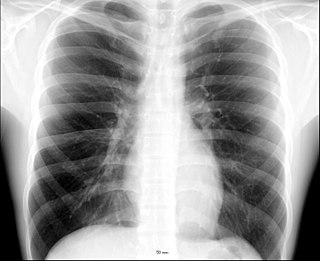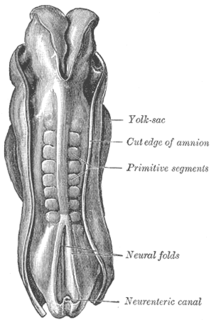The Furongian is the fourth and final series of the Cambrian. It lasted from 497 to 485.4 million years ago. It succeeds the Miaolingian series of the Cambrian and precedes the Lower Ordovician Tremadocian stage. It is subdivided into three stages: the Paibian, Jiangshanian and the unnamed 10th stage of the Cambrian.
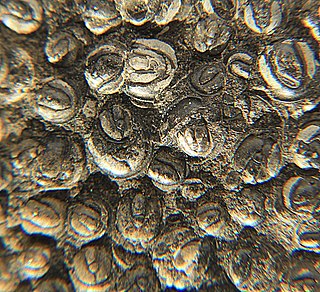
Agnostus is a genus of agnostid trilobites that lived during the upper Middle Cambrian–lower Upper Cambrian. It is the type genus of the family Agnostidae. It is subdivided into two subgenera, Agnostus and Homagnostus.
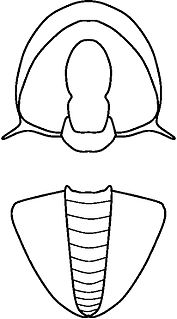
Acidiscus is an extinct genus of eodiscinid agnostid trilobites. It lived during the Botomian stage of the Cambrian period.
Acadagnostus is a genus of trilobite from the Middle Cambrian, with 7 species currently recognized. The type species A. acadicus has the widest distribution known from any peronopsid and has been found in North America, Greenland, England, Western Europe, Eastern Europe, Central Asia, the Altai Mountains, the Siberian shield, China, and Australia.

Peronopsis is a genus of trilobite restricted to the Middle Cambrian. Its remains have been found in Asia, Australia, Europe, and North America.

The Wheeler Shale is a Cambrian (c. 507 Ma) fossil locality world-famous for prolific agnostid and Elrathia kingii trilobite remains and represents a Konzentrat-Lagerstätten. Varied soft bodied organisms are locally preserved, a fauna and preservation style normally associated with the more famous Burgess Shale. As such, the Wheeler Shale also represents a Konservat-Lagerstätten.

Pagetia is a genus of very small, agnostid trilobites, assigned to the family Eodiscidae, and that had a global distribution during the Middle Cambrian. The genus contains 55 currently recognized species, each with a limited spatial and temporal distribution.
The Guzhangian is an uppermost stage of the Miaolingian Series of the Cambrian. It follows the Drumian Stage and precedes the Paibian Stage of the Furongian Series. The base is defined as the first appearance of the trilobite Lejopyge laevigata around 500.5 million years ago. The Guzhangian-Paibian boundary is marked by the first appearance of the trilobite Glyptagnostus reticulatus around 497 million years ago.
The Drumian is a stage of the Miaolingian Series of the Cambrian. It succeeds the Wuliuan and precedes the Guzhangian. The base is defined as the first appearance of the trilobite Ptychagnostus atavus around 504.5 million years ago. The top is defined as the first appearance of another trilobite Lejopyge laevigata around 500.5 million years ago.

Ptychagnostus atavus is a species of agnostid trilobite. It belongs to the genus Ptychagnostus in the family Ptychagnostidae. It was originally described by Swedish paleontologist Sven Axel Tullberg as Agnostus atavus in 1880. It is used in biostratigraphy as an index fossil. Its first appearance at the GSSP section in the Wheeler Shale of Utah is defined as the beginning of the Drumian Age of the Miaolingian.

Lejopyge laevigata is a species of agnostid trilobite belonging to the genus Lejopyge. It existed during the Guzhangian to the Paibian Age of the Cambrian. It has a cosmopolitan distribution and is an important index fossil in biostratigraphy.
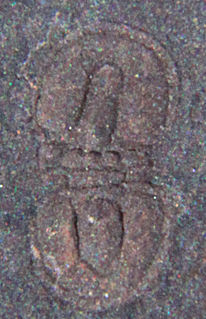
Pentagnostus is a genus of trilobites restricted to the Middle Cambrian. Its remains have been found in Siberia, Australia, North America, Scandinavia, and Kazakhstan.
The Miaolingian is the third Series of the Cambrian period, and was formally named in 2018. It lasted from about 509 to 497 million years ago and is divided into 3 stages: the Wuliuan, the Drumian, and the Guzhangian. The Miaolingian is preceded by the unnamed Cambrian Series 2 and succeeded by the Furongian series.

Glyptagnostus reticulatus is a species of agnostid trilobite belonging to the genus Glyptagnostus. It existed during the Paibian Age of the Cambrian. It has a cosmopolitan distribution and is an important index fossil in biostratigraphy. It was characterized by an unusual net-like pattern of furrows on both the cephalon and the pygidium.
Agnostotes orientalis is a species of agnostid trilobite belonging to the genus Agnostotes. It existed during the Jiangshanian Age of the Cambrian. It is an important index fossil in biostratigraphy.

The Peronopsidae comprise the earliest family of the Agnostina suborder. Species of this family occurred on all paleocontinents. The earliest representatives of this family first occur just before the start of the Middle Cambrian, and the last disappeared just after the start of the Upper Cambrian.
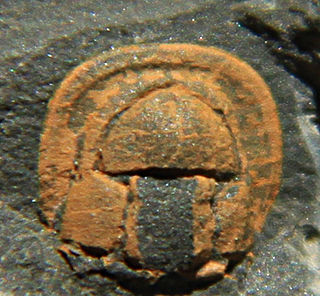
Condylopyge is a genus of very small trilobites, that lived during the latest Early and the early Middle Cambrian, in what are today Canada, Czech Republic, England and Wales, France, Germany, Italy, Morocco, the Russian Federation, Spain, Turkey and Sweden. It can easily be distinguished from all other Agnostida because the frontal lobe of the central raised area of the headshield is wider than the rear lobe. It looks like Pleuroctenium but the frontal glabellar lobe does not fold around the rear lobe, as it does in Pleuroctenium.

Eodiscidae is a family of agnostid trilobites that lived during the final Lower Cambrian and the Middle Cambrian. They are small or very small, and have a thorax of two or three segments. Eodiscidae includes nine genera.
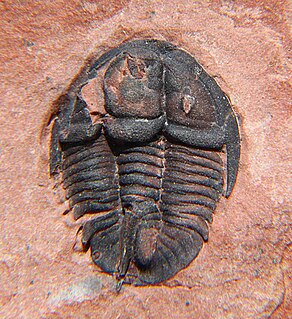
Genevievella is a genus of trilobites with a short inverted egg-shaped outline, a wide headshield, small eyes, and long genal spines. The backrim of the headshield is inflated and overhangs the first of the 9 thorax segments. The 8th thorax segment from the front bears a backward directed spine that reaches beyond the back end of the exoskeleton. It has an almost oval tailshield with 5 pairs of pleural furrows. It lived during the Upper Cambrian in what are today Canada and the United States.





